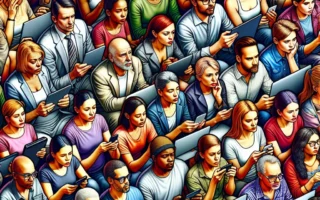– The Impact of Media Consumption on Viewing Behavior
Media consumption plays a crucial role in shaping the viewing habits of individuals. With the proliferation of diverse media platforms and content, people’s viewing behavior is significantly influenced by what they consume. The impact of media consumption on viewing behavior is evident in the shift from traditional TV viewing to online streaming services and on-demand content.
Consumers are now exposed to a plethora of choices, allowing them to tailor their viewing experience to their preferences. The extensive availability of content through various media channels has led to a transformation in how audiences engage with television shows, movies, and other visual content. This shift is attributed to the accessibility and convenience offered by online media platforms, enabling viewers to consume content at their convenience.
Furthermore, the personalized nature of media consumption, where viewers can curate their own playlists and recommendations based on their interests, has redefined the way people discover and engage with content. The algorithms used by media platforms to suggest content based on users’ viewing history and preferences have a direct impact on their viewing behavior, influencing the choices they make and the time they allocate to watching specific content.
It is evident that media consumption has not only diversified the options available to viewers but has also altered their viewing patterns and preferences. As individuals continue to consume media through a variety of platforms, understanding the intricate relationship between media consumption and viewing behavior becomes essential for media providers and producers to cater to the evolving needs of their audience.
– Analyzing the Link Between Media Consumption and Watching Patterns
When it comes to understanding the watching patterns of individuals, it is crucial to analyze the link between media consumption and viewing habits. Media consumption plays a significant role in shaping the preferences and behaviors of audiences. With the increasing availability of diverse media platforms, including television, online streaming services, and social media, individuals have a plethora of options for consuming content. This abundance of choices has a direct impact on their watching patterns.
Research indicates that the type of media consumed has a measurable influence on watching habits. For example, individuals who predominantly consume visual content through social media platforms may exhibit shorter attention spans when watching longer-form television shows or movies. On the other hand, individuals who regularly engage with high-quality, long-form content may have a preference for in-depth storytelling and character development.
Furthermore, the frequency of media consumption also affects watching patterns. Those who consume media content daily may have different viewing habits compared to individuals who only engage with media occasionally. For instance, regular consumers of media may develop a habit of binge-watching entire series in a short period, whereas occasional consumers may prefer to savor one episode at a time.
Understanding the intricate link between media consumption and watching patterns is essential for content creators and providers. By analyzing the impact of media consumption on individuals’ viewing habits, they can tailor their content to better resonate with their target audience. Additionally, for researchers and marketers, this knowledge offers valuable insights into the dynamics of audience behavior and preferences in the ever-evolving media landscape.
– Understanding How Media Consumption Shapes Viewing Habits
Understanding how media consumption shapes viewing habits is crucial in today’s digital age. With the abundance of content available across various platforms, it’s important to explore the factors influencing individuals’ watching behaviors. Media consumption plays a significant role in molding the preferences and habits of audiences. The types of media a person engages with, such as streaming services, social media, or traditional television, can greatly impact their viewing habits.
Research indicates that the more time individuals spend consuming media, the more likely they are to develop specific viewing patterns. For example, individuals who frequently consume online streaming content may develop a preference for binge-watching entire series in one sitting. On the other hand, those who rely on traditional television may adhere to scheduled programming and linear viewing.
Furthermore, the targeted advertising and personalized recommendations prevalent in online media consumption can profoundly influence individuals’ viewing habits. Algorithms that suggest content based on previous viewing history can lead to a reinforcement of specific genres or themes, ultimately shaping what individuals choose to watch.
Understanding the relationship between media consumption and viewing habits is essential for content creators, advertisers, and platforms aiming to capture and retain audiences’ attention. By recognizing the impact of media consumption on viewing behaviors, industry professionals can tailor their strategies to effectively engage and cater to the preferences of their target audience.



